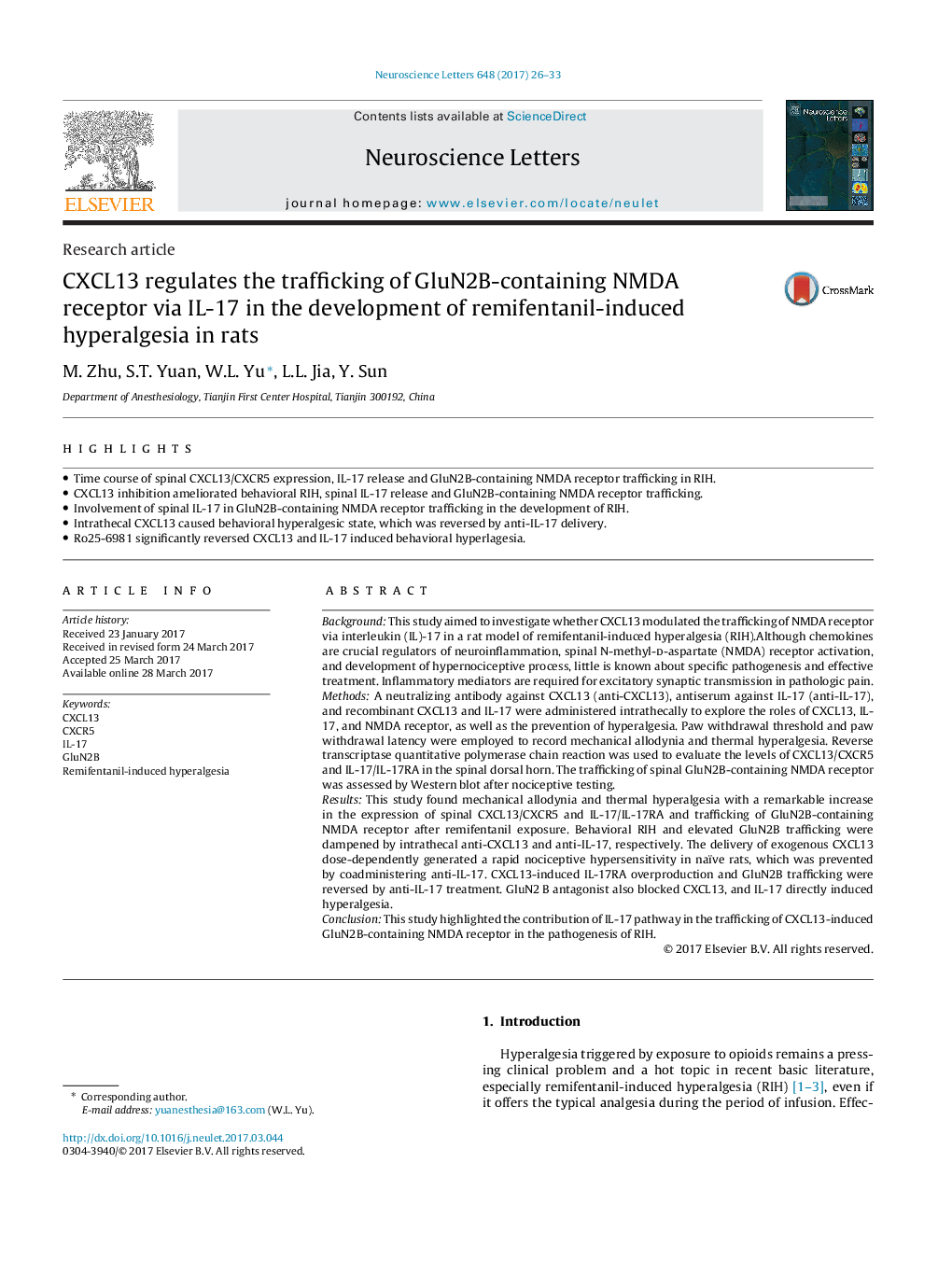| کد مقاله | کد نشریه | سال انتشار | مقاله انگلیسی | نسخه تمام متن |
|---|---|---|---|---|
| 5738458 | 1615051 | 2017 | 8 صفحه PDF | دانلود رایگان |

- Time course of spinal CXCL13/CXCR5 expression, IL-17 release and GluN2B-containing NMDA receptor trafficking in RIH.
- CXCL13 inhibition ameliorated behavioral RIH, spinal IL-17 release and GluN2B-containing NMDA receptor trafficking.
- Involvement of spinal IL-17 in GluN2B-containing NMDA receptor trafficking in the development of RIH.
- Intrathecal CXCL13 caused behavioral hyperalgesic state, which was reversed by anti-IL-17 delivery.
- Ro25-6981 significantly reversed CXCL13 and IL-17 induced behavioral hyperlagesia.
BackgroundThis study aimed to investigate whether CXCL13 modulated the trafficking of NMDA receptor via interleukin (IL)-17 in a rat model of remifentanil-induced hyperalgesia (RIH).Although chemokines are crucial regulators of neuroinflammation, spinal N-methyl-d-aspartate (NMDA) receptor activation, and development of hypernociceptive process, little is known about specific pathogenesis and effective treatment. Inflammatory mediators are required for excitatory synaptic transmission in pathologic pain.MethodsA neutralizing antibody against CXCL13 (anti-CXCL13), antiserum against IL-17 (anti-IL-17), and recombinant CXCL13 and IL-17 were administered intrathecally to explore the roles of CXCL13, IL-17, and NMDA receptor, as well as the prevention of hyperalgesia. Paw withdrawal threshold and paw withdrawal latency were employed to record mechanical allodynia and thermal hyperalgesia. Reverse transcriptase quantitative polymerase chain reaction was used to evaluate the levels of CXCL13/CXCR5 and IL-17/IL-17RA in the spinal dorsal horn. The trafficking of spinal GluN2B-containing NMDA receptor was assessed by Western blot after nociceptive testing.ResultsThis study found mechanical allodynia and thermal hyperalgesia with a remarkable increase in the expression of spinal CXCL13/CXCR5 and IL-17/IL-17RA and trafficking of GluN2B-containing NMDA receptor after remifentanil exposure. Behavioral RIH and elevated GluN2B trafficking were dampened by intrathecal anti-CXCL13 and anti-IL-17, respectively. The delivery of exogenous CXCL13 dose-dependently generated a rapid nociceptive hypersensitivity in naïve rats, which was prevented by coadministering anti-IL-17. CXCL13-induced IL-17RA overproduction and GluN2B trafficking were reversed by anti-IL-17 treatment. GluN2Â B antagonist also blocked CXCL13, and IL-17 directly induced hyperalgesia.ConclusionThis study highlighted the contribution of IL-17 pathway in the trafficking of CXCL13-induced GluN2B-containing NMDA receptor in the pathogenesis of RIH.
Journal: Neuroscience Letters - Volume 648, 1 May 2017, Pages 26-33